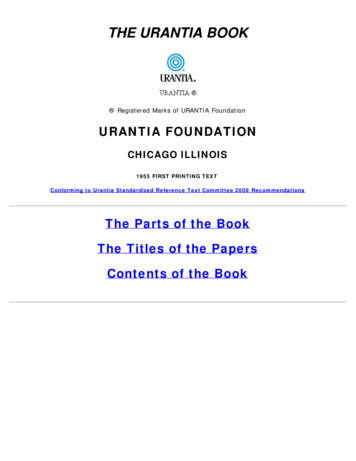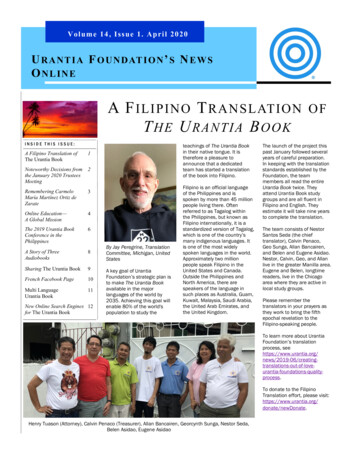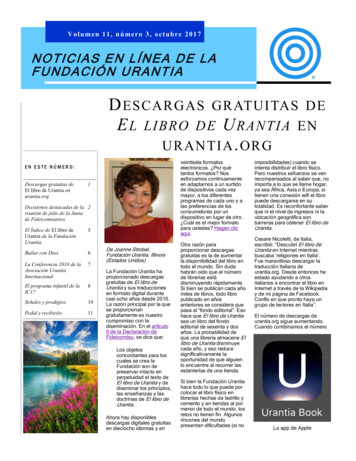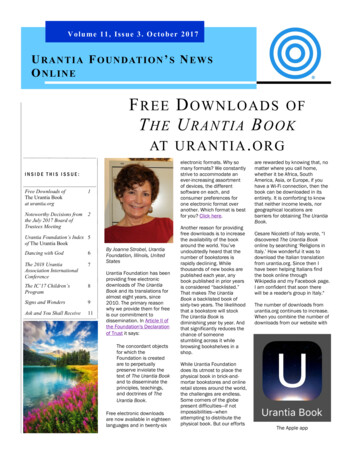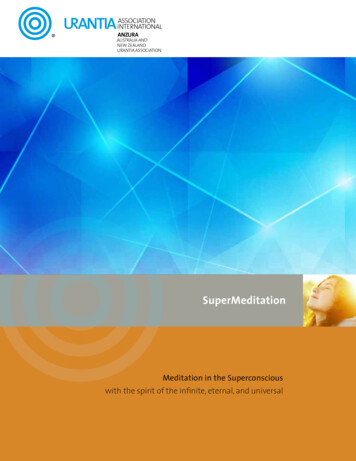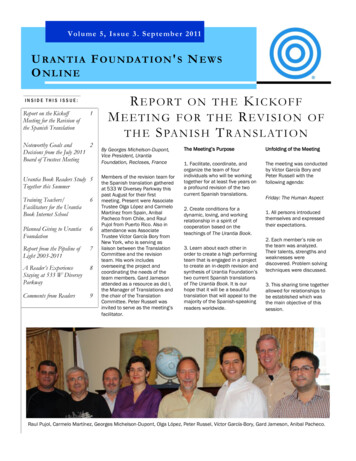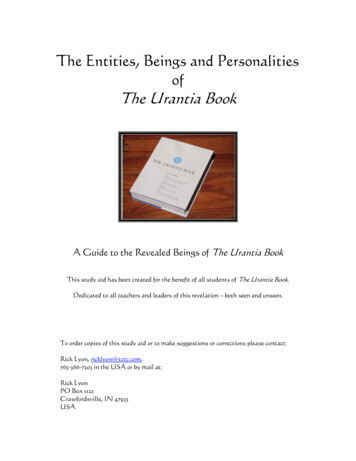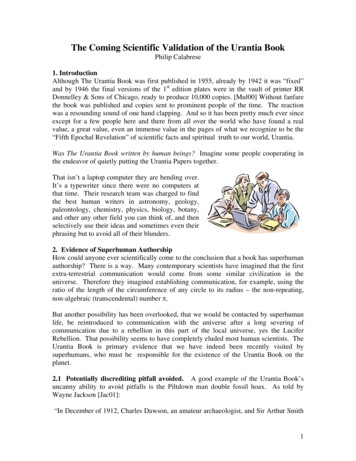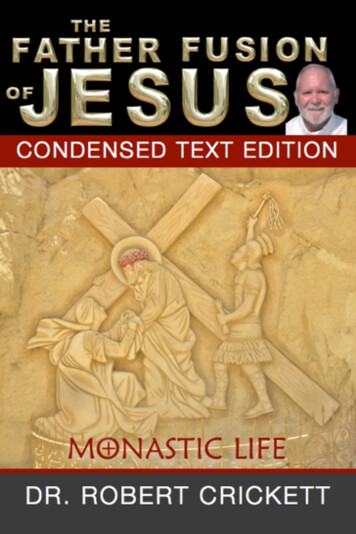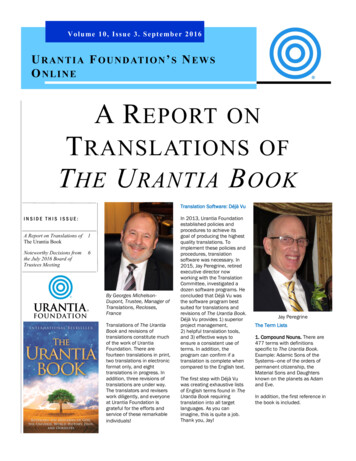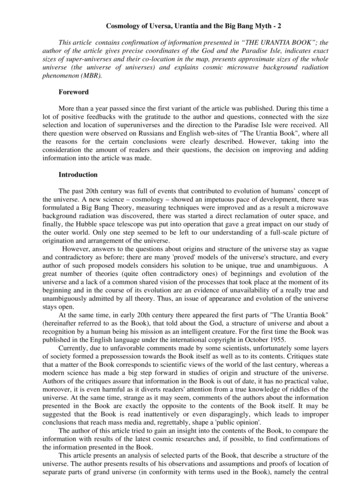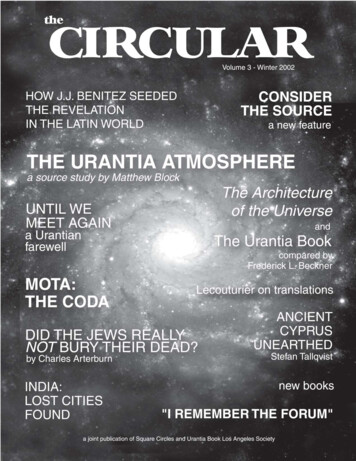
Transcription
WINTER 20021Apublication of Urantia Book Los Angeles Society and Square Circles Publishing
THE CIRCULARBOOKSFeatured bookfrom square circles publishingSOURCE AUTHORS OF THE URANTIA BOOK by J. T. Manning.(Square Circles, 2002) 536 pp., 24.95.Source Authors of the Urantia Book is a companion volume to the soon-to-be-published book by MatthewBlock, tentatively titled The Urantia Book Unveiled, Papers 85-103. In this book, J. T. Manning profilestwenty-four God-knowing men and women whose insights and inspirations were incorporated into theUrantia Papers. This edition includes substantially new and rewritten material on the ten authors featuredin the first edition (Baillie, Garnett, Grensted, Hocking, Hopkins, Jefferson, Knudson, Lewis, WestcottWieman, and Wieman), as well as biographical material on fourteen additional authors. From the preface:“The source authors chosen for this book were identified by Matthew Block in the 1990s and, in mostcases, subsequently confirmed by [fellow researcher] Steve Dreier. To date, Block has discovered over 125source books and articles written by over 90 authors. Twenty of the 24 authors described in this volumeare those whom Block has identified as source authors for Papers 85-103 in the Urantia Book. Otherpapers in the Urantia Book also incorporate material from these 20 authors. The remaining four authorssupplied source material only for other papers: Eddington, Jeans, and Swann (Papers 41, 42, 57) and Bundy(Paper 196).” The primary purpose of this work is to facilitate in-depth study of the source authors and their ideas. Each chapter containsa biographical sketch of the source author, an analysis of his work, a list of his books and selected published articles, a list of secondary worksabout the author and his work, and reviews about the particular book(s) sourced by the Urantia Book. In a format that leaves room for moreauthors to be added as they are discovered, Source Authors of the Urantia Book is a must-have for all serious UB readers.THE SHERMAN DIARIES, Volume One: DAWNING REVELATIONS 1898-1942. SaskiaPraamsma with Matthew Block.(Square Circles, 2003) 500 pp., 19.95. This book is the first of five volumes recounting the life of Harold andMartha Sherman and their five-year association with the Urantia Forum.Throughletters, diaries, notes and autobiographicalwritings, we follow the Shermans fromtheir youth and their New York and Hollywood days to their fateful association withForumite Harry Loose, who introduced them to the Urantia concepts.Volumes Two and Three (to be published in 2003), consist of diaries theShermans kept while attending the Forum and includes their continuingcorrespondence with Loose until his death in 1943; Volume Four comprises detailed diaries from 1944-1947, with outlines of the papers as theywere being read each Sunday to the group; Volume Five covers the years afterthe Shermans left Chicago, their correspondence with the Forumiteswho befriended them, and their continuing interest in Urantia affairs.THE STORY OF EVERYTHINGAS TOLD IN THE URANTIABOOK, An Overview by MichelleKlimesh. (Square Circles, 2003)292 pp., 14.95. For those seeking asummary of the 196 papers of theUrantia Book, Michelle Klimesh hasdevoted the past eight years to distillingthem into a compact volume that retainsthe vast scope of the original whileomitting much of the detail. MatthewBlock calls it “the best condensed versionof the Papers I have ever read.”2HOW I FOUND THE URANTIABOOK Compiled by SaskiaPraamsma. (Square Circles, 2001)400 pp., 14.95. The new and enlargedversion of HIFTUB contains 324 firstperson accounts of how people first foundthe Urantia Book and what it has meantto them. The testimonies are groupedchronologically, starting with Concordexauthor Clyde Bedell who joined theForum in Chicago in 1924, leading to theearly readers who found the revelationright after publication in the mid ’50s,through the psychedelic haze of the ’60s and early ’70s, to the “MeGeneration” ’80s, the computer-generated ’90s, and ending with a blindreader who found the book on the Internet in 2001.SOUL WINNING TEXTS by Dr.William S. Sadler, Foreword byMatthew Block. (Square Circles,1999) 116 pp., 11.95. Dr. William S.Sadler’s little-known first book, originallypublished in 1909, has been reprinted forits historic value as it relates to the Urantiarevelation.This small volume offers a glimpseinto the 34-year-old Sadler’s vigorousattempts to win souls to Christ throughpersonal evangelism. The book also reflectsSadler’s adherence to the teachings of EllenG. White, the guiding light of the Seventh-day Adventist Church, ofwhich Sadler was still a devout member when he compiled this book.All Square Circles titles are available either directlythrough www.squarecircles.com or Amazon.com
WINTER 2002. . . moreBOOKSTHE QUEST FOR GOD IS EVERYTHING (Theoquest.com,2002) 18 pp., 5.95. For those who find the entire Urantia Bookintimidating at first, this attractive 24page, full-color booklet (produced bya team of Urantia Book readers atTheoquest.com working together withnon-readers) presents an introductionto Urantia Book concepts in auser-friendly format. Its four sectionsgive a glimpse of how the UrantiaBook is laid out. Available throughTruthbook.com or in PDF format atwww.TheoQuest.com, a non-profitwebsite dedicated to helping people ontheir personal journey Godward.“The Quest for God Is Everything offers the best—and most direct—access route to the mysteries of The Urantia Book.”—Elaine Pagels, Ph. D.A HISTORY OF THE URANTIAPAPERS by Larry Mullinswith Dr. Meredith Sprunger.(Penumbra Press, 2000) 450pp., 24.95 This carefully documentedhistory, written by two long-timeUrantia Book readers, unfolds factsabout the origin and history of theUrantia Papers, beginning withbackground information on Dr. Sadlerand previously published accounts of hisfirst meeting with the sleeping subjectsometime between 1906-1911. Thevarious available histories are compared, taking us from the preForum and Forum years, through the “Sherman rebellion” of 1942,to the years of patient working and waiting that led up to bookpublication in 1955. Changes to the text in subsequent printings,and whether they were authorized by humans or celestials, is thefocus of the book from then on. Merritt Horn’s excellent scholarlyanalyses and conclusions as he details each of the changes, providesthe serious student of semantics with something to bite into. Includesmany never-before-seen photos of Forumites and other luminariesin the Urantia movement. Available on Amazon.com.THE ZOOID MISSION, by Gerdean.(Harp of God 2002) 475 pp., 25.00inc. postage. In this contemporarynovel, inspired by Urantia Paper 72, theleading characters guide the readerthrough a complex plot into theadvanced civilization of Zooids, a societyof altruists who reveal a new world order,a Camelot for the fifth epoch. Availablethrough O’Dell-Bowen Enterprises, P.O.Box 27714, Albuquerque, NM 871257724. www.ZooidMission.com.THE SECRET REVELATION—UNVEILING THEMYSTERY OF THE BOOK OF REVELATION by StellaReliga with Byron Belitsos. (Origin Press, 2002) 375 pp., 21.00. This work reconstructs and reinterprets the Book ofRevelation—easily the most controversial religious document inChristendom, with its frightening descriptions of end times andthe apocalypse. According to the Urantia Book, what we have inthe Bible “. . . contains thesur viving fragments of a greatrevelation, large portions of whichwere lost, other portions of whichwere removed, subsequent to John'swriting." The Secret Revelationconfirms those findings, corrects theerrors, and adds new insights. Witha combination of Urantia Bookknowledge and celestial help, Ms.Religa allows John the Revelator tospeak once again, to reveal what heactually saw and wrote, and tounveil for the first time the sublimegrandeur of his original vision—not one of doom anddestruction one but of love and mercy, with gentle but firmwarnings to future believers.“A practicing Christian who loves the Bible because of the lovableJesus it portrays, I stayed away from the Book of Revelation . . . untilsomething came along which had the ring of truth. That ‘something’ isThe Secret Revelation, [which] portrays a friendly universe in whichmighty angels are personally concerned with every human being. This isa God I can love instead of fear.”—Duane Faw“The Spirit of Truth spoke to me with each page that I read.”—Larry Whelan“Finally! Explanations for the Book of Revelation that makesense!”—Rebecca BynumTEACH US TO LOVE by DonnaD’Ingillo (Stillness Foundation,2002) 179 pages, 15.00 pluspostage. Subtitled “The manual tofind unconditional love for yourselfand others,” this book helps overcomethe barriers of guilt and feelings ofunworthiness by presenting new waysto look at oneself as a beloved child ofGod which trigger feeling the immensepersonal love God has for us. Alsoexplored are forgiveness, prayer, service,and healing as a means of deepeningone’s ability to love and be loved. Donna D’Ingillo is thefounder and director of the Center for Christ Consciousnesslocated in Larkspur, CA at www.ctrforchristcon.org. She is also aco-founder of the Stillness Foundation in Indianapolis, IN. To order,call (415) 464-1342 or email: donnadingillo@juno.com. Alsoavailable through Amazon.com.3
THE CIRCULAR. . . and moreA MILLENNIAL DREAM, byArthur Spintale. (1stbooks Library,2002) 176 pp., 14.50. Arthur Spintaleis the psuedonym for a long-time UrantiaBook reader, a retired medical doctor nowliving in upstate New York. In this novelhe tells the story of a young high schoolteacher, Sylvia, who starts a Thinking Clubfor bright students, and her would-besuitor, Arthur. On his way to a meetingof the club, Arthur is unexpectedlytransported to another world where he seeshuman societies in various stages ofdevelopment and where he talks with the inhabitants about law, religion,human behavior and spirituality. Available through Amazon.com.THE SEARCH FOR 11:11, AJOURNEY INTO THE SPIRITWORLD, by George MathieuBarnard. (Origin Press, 2002) 243pp., 15.00. The loyal midwayers aresaid to belong to a group of just 1,111in number. Australian George Barnard,who claims to have worked closely withthem as a healer and teacher evenbefore finding the Urantia Book,details the midwayers’ often humorousattempts to contact mortals throughthe 11:11 time prompt. Availabledirectly through www.originpress.com or Amazon.com.BOOKSTHE NEW PARAMONY,compiled by Duane L. Faw.(Uversa Press, 2002) 15.00plus 5 shipping. In this new edition,the original 25,000 cross referencesbetween the Bible and the UrantiaBook have been expanded to 40,000,and Duane has added key wordheadings as an additional study aid.Fellow Urantia Book reader LarryWatkins’ programming skills werehelpful in putting the Paramony intoa reader-friendly format. “It was something that needed to be done,and I had the time so I took it on,” said Duane, describing his yearsof dedication in producing the Paramony. To order, call (877)2883772. It will soon also be available on CD and can be found onlineat www.urantiabook.org/index bible.htm.BRAILLE URANTIA BOOK According to Dick Johnson ofthe Grand Canyon Society, a Braille copy of the Urantia Book,consisting of 41 two-sided volumes, is available to lend. Prepared byThe Braille Institute of Los Angeles, this rendition is believed to bethe only one of its kind. A maximum of two volumes are lent at atime; additional volumes are sent after the first are returned. Theyare labeled according to the numbers of the papers, so requests shouldspecify which papers are desired. The Society has contacted variousagencies for the blind to let them know of the availability of theUrantia Book both in the Braille and audiocassette tape versions.Email Dick at phxrusty@juno.com or write to Grand Canyon Society,P.O. Box 2621, Scottsdale, AZ 85252-2621.THE URANTIA BOOK:Uversa Press Edition vs. UF’s Traditional VersionTHE FIRST THING about theUrantia Book that appealed to mewhen I began to tackle it was that itread like a big, fat juicy novel andnot a Bible. Here the mysteries ofthe universe were being revealed ina no-nonsense way, and you didn’teven have to be a Christian or go tochurch or read the Bible to haveaccess to this information! I lovedthe lines going all the way across the page with no fancy numberingcode to distract me at the front of each paragraph. I could reallyget into what it was saying without being hampered by the ideathat this was a “sacred” book. Perhaps that’s because I had alwaysbeen a skeptic and this was my first exposure to Truth. I feltcomfortable showing it to non-believers because it didn’t looklike a Holy Book, just a big book of knowledge. So when I heardthat the Fellowship was printing a version with a traditional Jesus4on the cover and double columnswith a numbering system like theBible, my reaction was negative.Instead of moving away from theBible and forward into the NewAge, we’re turning back, for heaven’ssake! This book will become overidentified with Christianity! Butnow that I look at the two versionsside by side, I can see the need forboth. The Foundation’s book is theone I still prefer and will share with my atheist and agnosticfriends, and the Fellowship’s version is perfect for Christianfriends looking for an expanded revelation of their beloved Bible;the double columns will make them feel at home, thus thetransition will be less jolting. I like having a choice. When thereis so much good news to publish and proclaim, you can’t havetoo many publishers! —Saskia Praamsma
WINTER 2002CONSIDERTHESOURCETRANSLATION UPDATESArabic: Completed in 1996 and handedover to the Foundation, the work has beenundergoing revision ever since.Bulgarian: Work is continuing.Chinese: Since 2000 a team of universityprofessors has been working simultansouslyon a modern and a classical Chinese version.One professor has created a special dictionaryto ensure accurate translation of UBterminology and concepts.Croatian: Nora Moakher continues herwork, funded by members of theFellowship’s Golden Gate Society.Estonian: The first draft was completed in1999 and final editing is now in progress.Farsi: Since 2000 work has begun inearnest and the team now includes threeindividuals, one of whom resides in Iran.German: The first draft was completed in2000 and is now being revised and edited.Greek: In 2000 a Greek translation teamof three was formed and authorized tobegin work.Indonesian: A husband-and-wife teamhave translated more than thirty papersinto Indonesian.Italian: An acceptable preliminarytranslation was completed in 1995 and therevisions are now in the final stages.Japanese: A team is currently beingformed.Lithuanian: Completed in 2002, theLithuanian version will soon be makingits debut.Norwegian: A part-time effort has beenunderway but work is slow due to lack offunding.Polish: Almost half the papers have beentranslated, many of which have beenedited at least once.Portuguese: Work has recently begun ona Portugeuse translation.Romanian: A team of two, working at therate of two papers per week, are nearingcompletion.Swedish: A team of longtime readers, bothFinnish and Swedish, has brought theproject close to publication.For more information visit UrantiaFoundation at www.urantia.org. The Circular is pleased to publicize all effortsto share the Urantia Book worldwide. Contactsyrp@earthlink.net with news and updates.Iwith Matthew BlockN MY twenty-six years with the Urantia Book, I have attended study groups whereI’ve pored and puzzled over many passages with other serious readers. Papers suchas the Foreword and “Universe Levels of Reality” are—as we all know—perenniallymind-boggling. But many of the more accessible papers contain passages which cause someof us to scratch our head or raise an eyebrow. Some arouse our curiosity by alludingto poets or pharaohs or scientists without naming them; others seem questionable asconcerns dates, events or other phenomena. Some are too obscure to really understand.In my ten years as a source researcher, I’ve found that the Urantia Book’s apparentsources shed light on many of these questions and issues. In comparing a puzzling UBpassage with its corresponding source text, I have often found myself saying, “Aha!Now I understand why I had questions about it!”Are you perplexed by, or curious about, certain statements in the Urantia Book,particularly in Parts III and IV, where sources are used most heavily? If so, send me yourquestion at mblock@flash.net, and I’ll try to supply you with a source-related answer.The two questions covered here appeared on the UBRON message board. I’vemodified the wording for clarity.Bundy’s Witty and Worshipful WordsmithingQI’m wondering why the phrase “and not by leadings, voices, visions, andextraordinary religious practices” is inserted into this sentence from p. 2089,referring to Jesus:The secret of his unparalleled religious life was this consciousness of the presence of God; andhe attained it by intelligent prayer and sincere worship—unbroken communion with God—and not by leadings, voices, visions, or extraordinary religious practices.In viewing this in the literary sense, I can think of only two possibilities: (1) He alsoexperienced leadings, voices, visions, and extraordinary religious practices, in addition to“intelligent prayer and sincere worship”; or (2) Others mentioned in the context of thisnarrative were experiencing voices, visions, and extraordinary religious practices, and thishad been a topic of an earlier discussion.Does anyone have a clue why this phrase was inserted?Well, to begin with, the entire sentence you quote was adapted from a sentencein Walter E. Bundy’s 1928 book, The Religion of Jesus. In fact, much of thepaper in which the sentence occurs (Paper 196, “The Faith of Jesus”) appearsto be the product of a consecutive paraphrasing of passages from this bookand its 1929 sequel, Our Recovery of Jesus.Bundy’s books were apparently chosen by the author of Paper 196 because hisconcepts and expressions about the faith of Jesus were “on target,” or at least congruentenough with the UB’s message to serve as a basis for adaptation. Like the UB (see, forinstance, p. 1100) Bundy maintains that Jesus was not a mystic or an ecstatic prophet.He distinguishes two modes of religious approach: one that involves visions and voices,and one that involves prayer and worship unaccompanied by extraordinary psychicphenomena. In discussing the religious consciousness of Jesus, Bundy repeatedly pointsup this distinction, placing Jesus squarely on the non-mystical, non-psychic side. Thesentence you cite is adapted from one of Bundy’s expressions of the dichotomy. I A5
THE CIRCULARsee why the statement might be curious, since this is the onlytime in the UB discussion where the opposition is made explicit.That sentence is the culminating statement of a remarkableparagraph, in which the meaning of prayer for Jesus is laid out ina striking list of features. What makes the passage even moreintriguing is that Bundy appears to have provided the basis, whichthe UB reworks in a creative and critical way.What follows are the parallels between p. 208 of Bundy’sThe Religion of Jesus and p. 2094 of the Urantia Book. I’ve boldedsome of the shared words and underlined significant differences:The Religion of JesusThe Urantia BookOn the whole, we maysay thatprayer for Jesus meant anexpression of need,To him prayer was a sincereexpression of spiritualattitude,a release of soul,a declaration of soul loyalty,a recital of personal devotion,an expression of thanksgiving,a relief of inner pressure,an avoidance of emotionaltension,conquest over severesubjective struggle,a prevention of conflict,an elevation and enrichmentof mind,an exaltation of intellection,increased consecrationa confession of supremedevotion,and devotion,thevalidationconsecration,adjustment and orientation,a technique for theadjustment of difficulties,a mobilization of personalpowersand the mighty mobilizationof the combined soul powersto perform, in short, theenergy and power by whichto live and work (208).to withstand all humantendenciestowardselfishness, evil, and sin.He lived just such a life ofprayerful consecration to thedoing of his Father’s willEven with an increaseof clearness and certainty andof personal power toperform, we do not see adiminishingbutanintensification of Jesus’prayer-life. His life ends withan almost awful climax—[contd]the cry to God de profundis(208).an enrichment of thought,andan invigoration of higherinclinations,a clarification of viewpoint,a freshened functioning offaith,a declaration of faith,a whetting of will,a transcendental surrenderof will,discovery and illumination,6restoration of confidencea sublime assertion ofconfidence,and courage,a revelation of courage,lifejust such a prayer.and he attained itNot in visions and voices,by intelligent prayer andsincere worship—unbrokencommunion with God—but in prayer andcommunion with God—and not by leadings, voices,visions,a consecration of impulse,a clarifying of vision,and ended histriumphantly withThe secret of his unparalleledreligious life was this consciousness of the presence ofGod;an ennoblement of desire, avindication of moral decision,a reinforcementrefreshment of spirit,ofor extraordinary religiouspractices.purely religious sources of lightand strength—Jesus learned thedivine will and found the personalpower to perform it (208).In comparing the two texts, I’ll touch upon two areas:substance and style.Substance: For Bundy, Jesus is the most religious man who everlived. Jesus’ religious life is exemplary because he is essentially and
WINTER 2002exclusively religious. Bundy maintains that Jesus was not God, northe Son of God, nor a God-man. His outstanding trait was not selfmastery or perfection of character, nor complete attunement withdivinity. Rather, in Bundy’s view, Jesus was, throughout his life, proneto the same struggles and weaknesses as the rest of humanity. Theexcellence of his religious life lay only in his constant and absolutedevotion to the will of God as he sought to understand it.The Urantia Book does not endorse Bundy’s understanding ofthe nature of Jesus, and only partially shares his interpretation of Jesus’spiritual attainment. The deviations in the parallels indicate some ofthese vital differences. Bundy’s descriptives—“need,” “release,” “relief,”“conquest over,” “restoration,” etc. —point to a Jesus still chronicallysubject to changing moods and ebbs and flows in faith. The UB deftlyreplaces these words, to depict Jesus’ prayer life as an expression of histriumphant faith and a validation of his self-mastery.Style: In reading the Bundy column, notice his alliterations1(“whetting of will,” “freshened functioning of faith,” etc.). Manyof his discussions are speckled with these alliterative touches. Onp. 160 he comments, in a compound alliteration: “[Jesus’] personalpiety was prosaic and moral rather than poetic and mystical.”On p. 194, on Jesus’ prayer life, the alliterations flow fast and free:In these periods of prayer engaged in by Jesus there is nothingto suggest the typical temper of the mystic. There are noindications of mystical mannerisms and methods, no seekingfor a severing of self, . no effort to effect a mystical mergingwith the object of prayer. No ecstatic elements, no visionaryvisitations seem to have invaded these retreats (194).Bundy’s alliterations in the chart above are absent in theUrantia counterpart, but a careful reading of the rest of Paper196 shows that some of his other ones are retained.In all my reading I don’t recall coming across prose as consistentlyalliterative as Bundy’s, though it is hardly likely that Bundy is theoutstanding alliterator in the history of English literature. Nevertheless,I can’t help wondering, in reading the following UB passage on theThought Adjusters, whether Bundy was its inspiration. . . .These Monitors are efficient ministers to the higher phases ofmen’s minds; they are wise and experienced manipulators of thespiritual potential of the human intellect. These heavenly helpersare dedicated to the stupendous task of guiding you safely inwardand upward to the celestial haven of happiness. These tirelesstoilers are consecrated to the future personification of the triumphof divine truth in your life everlasting. They are the watchfulworkers who pilot the God-conscious human mind away fromthe shoals of evil while expertly guiding the evolving soul of mantoward the divine harbors of perfection on far-distant and eternalshores. The Adjusters are loving leaders, your safe and sure guides.; they are the patient teachers who so constantly urge theirsubjects forward in the paths of progressive perfection. They arethe careful custodians of the sublime values of creature character(1203).Bested by Breasted?QOn p. 1045 the Urantia Book says: “The word judgmentappears only once in the entire Book of Hebrew Psalms,and that particular psalm was written by an Egyptian.”1 Alliteration. n. the recurrence of the same initial sound (not necessarily letter) inwords in close succession, as ‘Sing a Song of Sixpence’.Since the UB doesn’t say which Psalm, I was inspired to go to Bible.comand do a word search on the King James Version. I was surprised tofind that the word “judgment” occurs 32 times! What gives? Can theUrantia Book be talking about a different translation of the Bible?When the Urantia Papers were first being received bytheir American audience in the 1920s and ’30s, the twomost commonly used versions of the Bible in the UnitedStates were the King James Version and the Revised Version. (Thelatter, published in the late 19th century, was a light revision ofthe former and should not be confused with the Revised StandardVersion in use today.) Theoretically the UB author may be alludingto some other, obscure English translation, but it is highly unlikelythat any would use the word ‘judgment’ just once. And since theword ‘judgment’ is an English word, it would be absurd to lookfor it in the Hebrew original or in any non-English translation.A clue to the UB’s intended meaning is found in the sentencewhich precedes the one in question. It reads: “The concept ofjudgment in the hereafter for the sins of one’s life in the flesh onearth was carried over into Hebrew theology from Egypt.”If we tweak the problematic sentence from “The wordjudgment appears only once . . .” to “The Egyptian concept of thejudgment hereafter, appears only once . . .,” then we narrow thepossibilities down considerably by searching on ‘the judgment.’The phrase ‘the judgment’ occurs more than once in the KingJames Version of the Book of Psalms, but only in one Psalm does itrefer to the judgment hereafter—Psalm 1. Verses five and six read:A[5] Therefore the ungodly shall not stand in the judgment,nor sinners in the congregation of the righteous.[6] For the LORD knoweth the way of the righteous: but theway of the ungodly shall perish.Obviously, this way of solving the problem doesn’t rely onsource consultation. However, the sentence in question and thesection in which it appears do use an apparent source, and thistext does shed light on the Urantia Book’s entire discussion ofearly Egyptian religion. Discovered by Scott Forsythe in the1980s, the source is The Dawn of Conscience (1934), written byJames Henry Breasted, a renowned American Egyptologist.On pp. 365 and 366 of his book, Breasted quotes a longpoem by Amenemope and shows its resemblance to passagesfrom the prophet Jeremiah. He goes on to comment: “Incontemplating Amenemope’s pleasing picture of the two trees,one is inevitably reminded of the first Psalm. . . . It is importantto notice that ‘the judgment’ appearing here [in the first Psalm]is the only mention of it in the entire Book of Psalms. This is asignificant hint [of Egyptian influence on the Hebrews], for ajudgment hereafter, as we have already seen, was thecontribution of Egyptian civilization.”But we’re still left with questions. Why didn’t anyone—theContact Commission, the Forum—notice the Urantia Book’smistake? And where in the chain of transmission did the mistakeoccur? Was it the result of a typo, or of a misreading of Breasted?You be the judge. Note: Both Bundy and Breasted are profiled in the new edition of Source Authorsof the Urantia Book: Papers 85 to 103, and Others. See p. 61 for ordering details.7
THE CIRCULARINDIA: LOST CITIES FOUNDCOMPILED BYSASKIA PRAAMSMATHE SUPERIOR CULTURE and religious leanings of the peoples of India date from the early times of Dravidiandomination and are due, in part, to the fact that so many of the Sethite priesthood entered India, both in the earlierAndite and in the later Aryan invasions. The thread of monotheism running through the religious history of Indiathus stems from the teachings of the Adamites in the second garden.As early as 16,000 B.C. a company of one hundred Sethite priests entered India and very nearly achieved the religiousconquest of the western half of that polyglot people. But their religion did not persist. Within five thousand years their doctrines of theParadise Trinity had degenerated into the triune symbol of the fire god.But for more than seven thousand years, down to the end of the Andite migrations, the religious status of the inhabitants ofIndia was far above that of the world at large. During these times India bid fair to produce the leading cultural, religious, philosophic,and commercial civilization of the world. And but for the complete submergence of the Andites by the peoples of the south, this destinywould probably have been realized.The Dravidian centers of culture were located in the river valleys, principally of the Indus and Ganges, and in the Deccanalong the three great rivers flowing through the Eastern Ghats to the sea. The settlements along the seacoast of the Western Ghats owedtheir prominence to maritime relationships with Sumeria.The Dravidians were
According to the Urantia Book, what we have in the Bible “. . . contains the surviving fragments of a great revelation, large portions of which were lost, other portions of which were removed, subsequent to John's writing." The Secret Revelation confirms those findings, corrects the errors, and adds new ins
